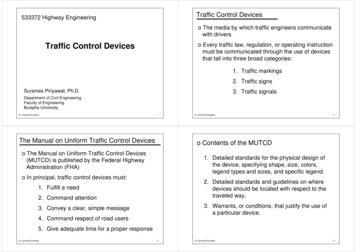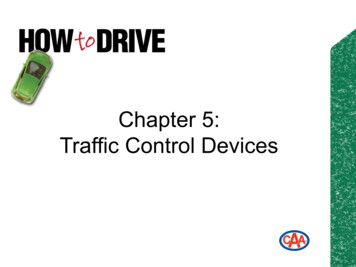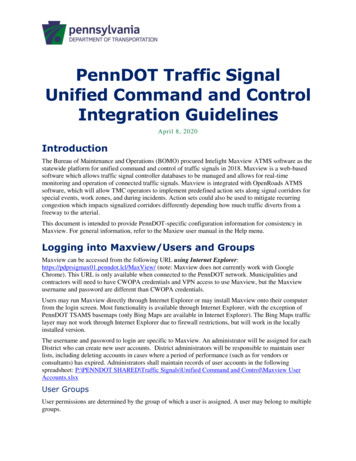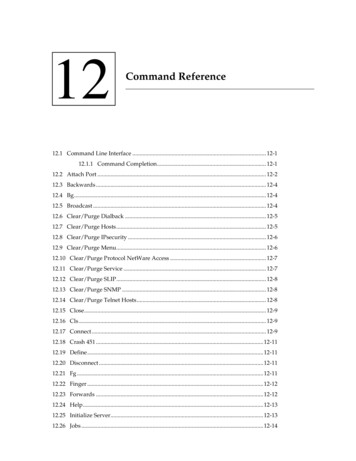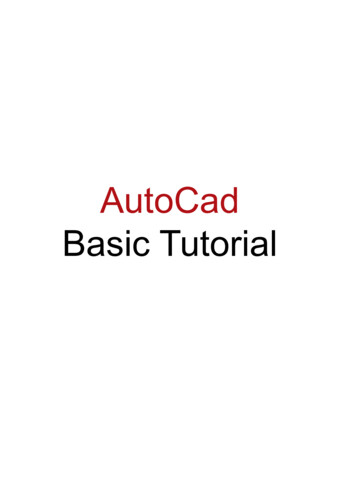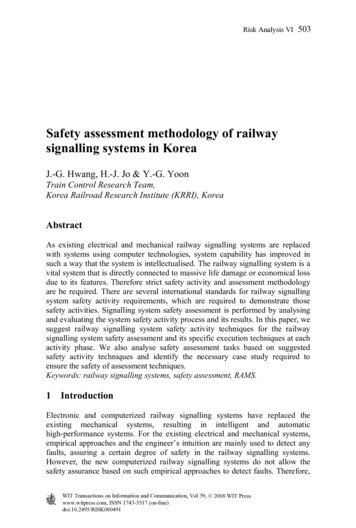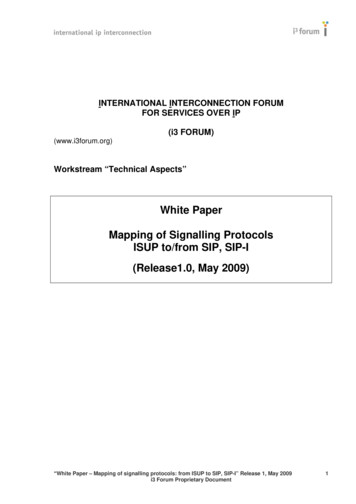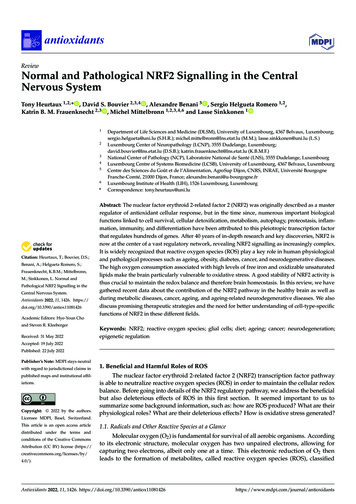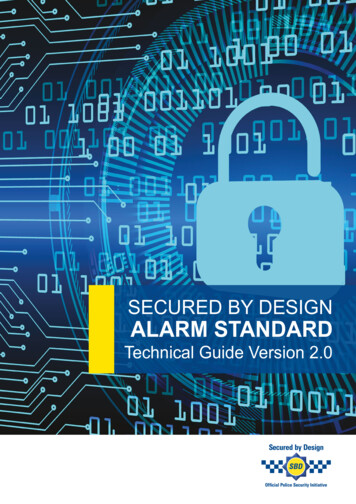
Transcription
Railway Systems Contract WorksInformationCommand, Control,Signalling and TrafficManagement (CCS & TM)WI3000 – Technical SpecificationSecurity Classification: OfficialHandling instructions: This document contains proprietary information. No part ofthis document may be reproduced without prior written consent from the ChiefExecutive Officer, HS2 Ltd.
HRS23 CCS and TM – Works Information 3000 – Technical 1.2Application111.3Requirements dards12Works Information 3000 Structure122.1Structure and Content122.2Document Format142.3Tender Evaluation14Abbreviations, Definitions and Defined Terms153.1CCS System Definitions153.2Rolling Stock Definitions223.3Network and Route Definitions233.4Human Actors253.53.63.4.1CCS System Users253.4.2Other Human Actors29Operating Modes303.5.1Normal Operations303.5.2Abnormal Operations303.5.3Degraded Operations313.5.4Emergency Operations313.5.5Under Maintenance31Other Definitions314[Intentionally left blank]325CCS System Requirements325.1CCS System Performance325.1.1Line Speed325.1.2Journey Times335.1.3Headways355.1.4Platform Operations385.2Transitions Between Signalling Systems405.3Bi-Directional Operation415.4Train Operations415.4.1Train Identification425.4.2Train Movement43OfficialPage 1
HRS23 CCS and TM – Works Information 3000 – Technical Specification5.5Control of the HS2 Infrastructure435.6Key Management455.6.1Online Key Management465.6.2Offline Keys for Testing and Trial Running475.7Communicating with Others485.8Unplanned stopping of Trains495.8.15.9ATO StopLow Adhesion on the HS2 Infrastructure505.10 Wind on the HS2 Network515.11 Data logging515.11.1Data Integrity5.12 CCS System Health and Fault Reporting5.12.1650CCS Maintainer HMI5253545.13 Alarm management555.14 Infrastructure and rolling stock faults565.15 CCS System Maintenance and Updates565.16 User Profiles575.17 CCS System User Training57Traffic Management System586.1Daily Timetable and Possession Plan586.2The Current Plan596.2.1Recalculating the Current Plan616.2.2Publish Current Plan656.3TMS Performance666.4Display & Control666.4.16.5HMI In Incident Management RoomAreas of Control6.5.1Flexible Areas of Control6970726.6Inhibiting Routes736.7Log-in746.8Train Running Number/Headcode756.9Route Setting and Coupling766.10 Resource dependencies and next working776.11 Train Delays and Updated timings796.12 Conflict Detection806.13 Conflict Resolution816.14 Manually update Current Plan following conflict836.15 Simulation846.16 Rolling Stock Restrictions86OfficialPage 2
HRS23 CCS and TM – Works Information 3000 – Technical Specification6.17 Cancelling Trains876.18 Inserting Trains886.19 Held Trains896.19.1OCS-related holds6.20 Passenger Load Based Amendments936.21 Updating Calling Pattern936.22 Speed Restrictions946.22.1Wind-related Speed Restrictions976.22.2Speed Restriction Requests from PMS976.23 Train Describer information986.24 TAP986.25 TMS Infrastructure Data1006.26 Train Wash1006.27 Written Orders1016.28 Replay1026.29 Tap-In Facility1026.30 Loss of connection to Signalling and ATO1036.31 TMS Interface with CAMS and Alarms, Alerts, Events1046.31.1CAMS HMI1066.32 TMS Interface with Telecoms System1086.33 TMS Interface with Signalling System1096.33.1Signalling information display on TMS HMI1096.33.2Call other route types1106.33.3Operate Trackside Assets1126.33.4Set Signalling Reminders1136.33.5Stop Trains1136.33.6Route Release1146.33.7Input Track Condition Data1156.33.8Signalling Staff Lockout1166.34 TMS Interface with ATO1176.35 TMS Interface with Adhesion Management System1186.36 TMS Interface with Possession Management System1206.36.1Begin a possession1226.36.2Supervise a Possession Area1236.36.3Amend a Possession Area1246.36.4Remove a Possession Area1256.37 TMS Interface with Overhead Catenary System and HV Power792Signalling System1251267.1Standards & Documentation1277.2Safe Movement of Trains127OfficialPage 3
HRS23 CCS and TM – Works Information 3000 – Technical Specification7.3Safe Routes1287.4General Signalling Requirements1297.5Movement Authorities1317.5.1On Sight Movement Authorities & Permissive Moves1367.6Lineside Signage & Asset Identification1387.7Lineside Equipment1417.7.1Buffer Stop Lighting1417.7.2Lineside Signals1427.8Balises1437.9HS2 Depots1467.10 Tunnel Ventilation Sections1477.11 Route Setting1477.12 Route Locking1497.13 Route Holding1517.14 Route Release1517.15 Route Bars1537.16 Point Locking1547.17 Points Detection1557.18 Points Control & Operation1597.19 Trap Points1637.20 Zones of Protection1647.21 Train Detection1647.22 Train Detection Reset1677.23 Train Detection Failures1687.24 Engineers Possession Reminder1697.25 Special Train Reminder1707.26 Stopping Trains1717.27 Start of Mission1737.28 Change of Travel Direction1757.29 Change of Train Running Number1757.30 Change of Driver ID1777.31 Platform Moves & Occupation1787.32 Loop Lines1797.33 RBC Handovers1807.34 Transitions1827.35 Temporary Speed Restrictions1937.36 Possessions1957.37 Traction Changeover & Neutral Sections1957.38 General Drivability196OfficialPage 4
HRS23 CCS and TM – Works Information 3000 – Technical Specification7.39 Text Messages1977.40 Shunting2007.41 Degraded and Emergency Operations2027.42 General Data2057.43 ETCS Specific Data2057.43.182067.44 Track Condition Functions2077.45 Signalling Lockout System2107.46 Signalling System Interfaces2127.46.1Signalling System Interface with CRN Interlocking2127.46.2Signalling System interface with Tunnel SCADA2137.46.3Signalling System Interface with Traffic Management System2147.46.4Signalling System interface with ETCS Onboard2167.46.5Signalling System Interface with HS2 Phase 2B217Possession Management System2188.1PMS Operational Context2188.2PMS Capacity and resolution2198.3PMS Functionality2208.4Transfer Possession Plan to HHT2228.5Transfer of Railway Control to PAM2238.5.19Packet 44 MessagesSet up Worksite within Possession Area2268.6Moveable Assets within Possession Area2268.7Transfer of Railway Control to new HHT or new PAM2278.8Changes to Possession Area2288.9Relinquish Worksite within Possession Area2298.10 Hand Back a Possession Area2298.11 Communicating with Trains in and around Possession Area2318.12 HHT Unit Design2328.13 HHT Location and Quantities2338.14 PMS-related Failures234ATO Trackside2359.1General2359.2Service Pattern and Planning2379.3Mixed Operation Performance2389.4ATO Signage2389.4.1Accurate Stopping Facilities2389.5Platforms2399.6Timing Points2419.7ATO / ATO Handovers242OfficialPage 5
HRS23 CCS and TM – Works Information 3000 – Technical Specification109.8Transitions2429.9ATO and Adhesion Management2449.10 Platform Skip2459.11 Stop at Preferred Stopping Location2469.12 Stop at Washwood Heath ATO Stabling Road2479.13 Stop at safe area2479.14 ATO Data2489.15 Communications Failures2519.16 Interface Failures2529.17 ATO Trackside Interfaces252Adhesion Management System10.1 Apply Adhesion Intervention25510.2 Supervise Adhesion Intervention Areas25710.3 Manually-defined Adhesion Intervention25710.4 Removal of Adhesion Intervention25710.4.1111314WSP Events during removal of Adhesion Intervention25810.5 AMS Data Review259Weather Monitoring System25911.1 Wind Sensors25911.2 Wind-related speed restrictions26011.2.112255Weather Monitoring System HealthEnterprise Service Bus26326312.1 General26312.2 ESB Failures26512.3 ESB Maintenance26512.4 Enterprise Service Bus Interfaces266Workstations26613.1 Workstations in the NICC OCR26613.2 Workstations in the Remote Tap-in Facility26713.3 Workstations in the NICC Training Facility26813.3.1Workstations in the NICC Group Training Facility26813.3.2Workstations in the Individual Training Facility27013.4 Workstation Industrial Design27013.5 Workstation Ergonomics27213.6 Workstation Lifespan27313.7 Workstation Cable Management27313.8 Local Workstation Lighting27313.9 Workstation Height Adjustment275CCS Training System275OfficialPage 6
HRS23 CCS and TM – Works Information 3000 – Technical Specification14.1 General Training System Requirements27614.2 Individual Training Facility27814.2.1Facilities for Trainees in the Individual Training Facility27814.2.2Facilities for Instructors in the Individual Training Facility27814.3 Group Training Facility14.3.1Facilities for Trainees in the Group Training Facility27814.3.2Facilities for Instructors in the Group Training Facility27814.3.3PAM Training System27914.4 Training Scenarios14.4.115Training Scenario Scripting27928014.5 Training Data Logging and Export28114.6 Training System Interfaces281CCS Lab28215.1 CCS Lab General Requirements28215.2 CCS Lab Functionality - General Requirements28315.3 CCS Lab Hardware - General Requirements28415.4 Integration of other systems into CCS Lab - General Requirements28415.4.1Integration of Onboard Systems into CCS Lab28415.4.2Integration of Operational Telecoms Systems into CCS Lab28515.4.3CCS Lab interface to Network Rail Systems28515.4.4CCS Lab interface to Network Rail ERTMS National Integration Facility28615.5 CCS Lab Simulators - General Requirements28615.6 Remote Connection to CCS Lab28815.7 CCS Development Platform28815.7.1CCS Development Platform Hardware28815.7.2CCS Development Platform Simulators28915.7.3CCS Development Platform Functionality29415.7.4CCS Development Platform Testing29515.8 CCS Operational Platform29715.8.1CCS Operational Platform Hardware29715.8.2CCS Operational Platform Software29715.8.3CCS Operational Platform Simulators29715.8.4CCS Operational Platform Functionality30015.9 CCS Lab Playback Facility1627830015.9.1Data Capture30115.9.2Replay30115.9.3Playback facility User Interface30215.10 CCS Lab in the Systems Integration Facility303CCS Alarm Management System16.1 Function305305OfficialPage 7
HRS23 CCS and TM – Works Information 3000 – Technical Specification16.2 Alarm Management Rules30616.3 Alarm Handling30716.4 Alarm Acknowledgement30816.4.1Internal Acknowledgements30816.4.2External Acknowledgements30916.5 Unique Alarm Identifiers30916.6 Alarm Configuration30916.7 Alarm out of service31016.8 Alarm Suppression31016.9 Alarm Recording31117[Intentionally Left Blank]31218Asset Containment Systems31218.1 Relocatable Equipment Buildings31218.1.1General31218.1.2REB Installation31318.1.3REB Access31318.1.4REB Security31518.1.5REB Earthing and Bonding31518.1.6Cables, Cable Ducts, Cable Entries, Cable Routes & Trays31618.1.7Electrical Requirements31718.1.8REB EMC31818.1.9REB Environment31818.1.10REB Walls31918.1.11REB Colours and signage32018.1.12REB Floor32018.1.13REB Roof32118.1.14Facilities for Mounting Equipment32118.1.15REB Fire32218.1.16HVAC32318.1.17Internal 20Operator32518.2 Trackside Cabinets32518.2.1General32618.2.2Cabinet Installation32618.2.3Cabinet Access32718.2.4Cabinet Bonding and Earthing32718.2.5Cabinet Cables, Cable Ducts, Cable Entries, Cable Routes & Trays32818.2.6Cabinet Electrical Requirements328OfficialPage 8
HRS23 CCS and TM – Works Information 3000 – Technical Specification18.2.7Cabinet EMC32918.2.8Cabinet Environment32918.2.9Cabinet External / Internal Walls33018.2.10Cabinet Roof33018.2.11Cabinet Colour scheme and signage33118.2.12Cabinet Facilities for Mounting Equipment33118.2.13Cabinet HVAC33218.2.14Cabinet Lighting33318.2.15Cabinet Lightning33318.2.16Noise and Vibration33318.3 CCS Assets in Equipment Rooms33419[Intentionally left blank]33420PRAM33420.1 General Availability Requirement33420.2 Use of Redundancy33420.3 CCS System PRAM33520.4 CCS System Functions PRAM33620.4.1Traffic Management tomatic Train Operation33720.4.5Enterprise Service Bus33720.5 Maintenance20.5.1Asset Identification20.6 Asset management21Fire Safety2333934034021.1 Fire Safety2233834021.1.1Cabling34021.1.2Equipment within Tunnels341Security34222.1 Physical Security34222.2 Cyber Security342Physical Environment and Noise23.1 Physical Environment and Noise34334324Ergonomics34525Earthing and Bonding34626Electromagnetic Compatibility34727Appendix A – Performance Calculations34827.2 Route profile and Line speeds34827.3 Tunnel cross sections348OfficialPage 9
HRS23 CCS and TM – Works Information 3000 – Technical Specification2827.4 Timing Point Locations34927.5 Rolling Stock performance parameters34927.6 Infrastructure Performance35227.7 Environmental Conditions352Appendix B - Weather sensor locations28.1 Proposed Outline Design29Appendix C - Preferred Stopping Locations354354358OfficialPage 10
HRS23 CCS and TM – Works Information 3000 – Technical Specification1Introduction1.1Purpose1.1.0-1This section of the Works information contains the Employer’s requirements in relation tothe Contractor’s design of the works.1.1.0-2It also contains technical definition of the works, which are described in WI 0100, andtechnical constraints on the way in which the Contractor Provides the Works.1.1.0-3The Employer’s process requirements related to systems integration, Contractor’s design,Digital Engineering and transverse processes are set out in WI 0300. The Employer’senvironmental and sustainability management requirements related to design andconstruction of the works are set out in WI 0285, with further technical details contained inthis WI 3000.1.2Application1.2.0-1This Works Information is applicable to HRS23.1.3Requirements Management1.3.0-1The Employer operates a requirements management process which captures, allocates,verifies and validates project requirements. The details of this process are set out in section3.3 of WI 0300.1.3.0-2The requirements described in this Works Information are captured in the Employer’srequirements management system, which uses a requirements management database(DOORS). This Works Information is managed in DOORS and changes to this WorksInformation are made in DOORS.1.3.0-3Any differences between this Works Information and the requirements captured in DOORSare notified to the Project Manager .1.4Compliance1.4.0-1The Contractor provides compliance evidence against the items contained within the textboxes in this Works Information, using the unique identifier as a reference in accordancewith WI 0300.Commercial in ConfidencePage 11
HRS23 CCS and TM – Works Information 3000 – Technical Specification1.5Terminology1.5.0-1This Works Information uses terms which are commonly understood in the field of railwayengineering. Further definitions are contained in section 3 and WI 0020.1.6Standards1.6.0-1HS2 standards and other referenced standards set out in this Works Information are listedin WI 2002.2Works Information 3000 Structure2.1Structure and Content2.1.0-1This document has the following sections:3 - Abbreviations, definitions and defined terms.4 - is intentionally left blank.5 - CCS System Requirements - defines key functional requirements for the CCS System as awhole. Sections 6 to 18 then provide further detailed requirements for functionality tobe delivered by the CCS System.6 - Traffic Management System - sets out requirements for the Traffic Management System whichprovides the Human Machine Interface for the Traffic Management Controller andcontrols and regulates the efficient movement of trains throughout the HS2 Network. Italso provides a single source of truth of the Current Plan to other HS2 and externalsystems.7 - Signalling System - sets out requirements for the Signalling System which is a NTSN compliantLevel 2 (with an option for Level 3 hybrid provision) European Train Control Systemcomprising ETCS Trackside equipment, Interlockings and trackside signallinginfrastructure.8 - Possession Management System - sets out requirements for the Possession ManagementSystem which works in conjunction with the Traffic Management System to enable thesafe conduct of engineering works on sections of the line as required.9 - ATO Trackside - sets out requirements for the Automatic Train Operation over ETCS systemwhich works in conjunction with TMS and the Signalling System to provide the tracksideinfrastructure necessary to enable Grade of Automation Level 2 operation of PassengerTrains on the HS2 Network.Commercial in ConfidencePage 12
HRS23 CCS and TM – Works Information 3000 – Technical Specification10 - Adhesion Management System - sets out requirements for the Adhesion managementSystem which acts upon received information from the Weather Monitoring System,the trains’ Wheel Slide Protection system and its own historical data; in conjunctionwith the TMS and ATO systems, to adjust the adhesion settings onboard trainsoperating in ATO in a specific area according to the levels of wheel-rail adhesionavailable.11 - Weather Monitoring System - sets out requirements for the Weather Monitoring Systemwhich monitors weather forecasts from external sources and actual weather conditionsfrom Trackside Wind Sensors; to inform the CCS HS2 System and Other HS2 Systemsabout the current prevailing weather conditions and the forecast for upcoming servicedays.12 - Enterprise Service Bus - sets out requirements for the ESB which is interfaced with variousCCS subsystems and applications, facilitating communication between them. The ESBde-couples the producer of information from any consumers allowing system changesand upgrades to take place independently.13 - Workstations - sets out the requirements for operator workstations that are to be provided atvarious locations to enable staff to operate the HS2 Railway.14 - CCS Operator Training System - sets out requirements for the CCS Operator Training Systemwhich is a stand-alone system to replicate the functionality of the CCS System, withsimulators, to allow the training of staff in the operation of the CCS System.15 - CCS Lab - sets out requirements for the CCS Lab which will be used to enable the thoroughtesting and integration of target hardware and software upgrades and modifications toany of the CCS Systems and sub-systems, both in the period leading to commissioningand after commencement of operations.16 - CCS Alarm Management System - sets out the requirements for the management of alertsand alarms of the CCS System.17 - is intentionally left blank18 - Asset Containment Systems - sets out requirements for relocatable equipment buildings,trackside cabinets, and equipment rooms, in which CCS System Assets can becontained.17 to 26 - Chapters containing Transversal requirements — sets out the requirements which areapplicable to all CCS sub-systems.2.1.0-2This WI3000 contains functional requirements for the design of the CCS System.Requirements for processes that shall be undertaken by the Contractor in designing theCommercial in ConfidencePage 13
HRS23 CCS and TM – Works Information 3000 – Technical SpecificationSystem to meet this WI3000 are defined in other sections of the Work Instruction. Linksbetween this document and other sections of the Work Instruction are highlighted whereappropriate.2.2Document Format2.2.0-1This WI3000 includes a combination of requirements and rationale to explain the source ofthe requirements. Requirements are provided in the following format:2.2.0-2CCS-10944 - Requirement NameExample requirement text.Rationale: Explanation of the requirement2.2.0-3Each requirement has a unique ID (CCS-###) and name. Only text contained within the boxis considered part of the requirement. There may be a number of separate statementsseparated by a line-break which must all be considered together as part of therequirement.2.2.0-4All other text is provided for guidance and information. 'Rationale' for the requirement hasbeen provided to explain the requirement's purpose and wider context.2.2.0-5Cross-references have been included to highlight where particular requirements relate toeach other.2.2.0-6The CCS System has been broken down into a number of CCS Sub-Systems, which eachdeliver the functions described herein, each in their own chapter of this document. HS2 hasdefined this system breakdown for the purpose of specification, but does not mandate thisstructure is adopted by the Contractor, provided that all functions are delivered by theoverall CCS System, except where explicitly noted in the introduction to the relevantchapter.2.3Tender Evaluation2.3.0-1Full details of the Tender Evaluation process are contained in the Invitation to Tender.Requirements of this WI3000 are either:2.3.0-2Mandatory, which is highlighted in the title of each requirement;scored; orcontribute to the whole life value model.Commercial in ConfidencePage 14
HRS23 CCS and TM – Works Information 3000 – Technical Specification3Abbreviations, Definitions andDefined Terms3.1CCS System Definitions3.1.0-1The CCS System nomenclature in this document is consistent with that listed in CCS NTSNSUBSET-023. Additional definitions specific to the HS2 application are listed in this section.Accurate Stopping Facilities - A means by which to enable manually-driven passenger trains tocorrectly berth at stopping locations within the specified stopping accuracy tolerance.Adhesion Intervention Area - The start and end location for the Low Adhesion Rate, including theexpected duration for the intervention.Adhesion Management System (AMS) - The Adhesion Management System acquires real time datafrom rolling stock wheel slip/slide events from the ATO trackside servers (relaying on-boardsystems information) which when processed provides the means by which adhesionmanagement is delivered in a predominantly automated mode of operation, but with thefacility for manual intervention if required.Alarm - An unexpected occurrence that requires time critical attention from a CCS System User or aCCS Sub-System. The CCS System User will be notified by audible or visible means.Alarm Flooding - A condition during which the Alarm rate is greater than the CCS System User caneffectively manageAlarm Management Rules - The specific rules assigned by the CAMS to an Alarm, Alert, or Event thatdetermine how it is to be treated by the receiving HS2 CCS Sub Systems or CCS SystemUsersAlarm Shelving - A mechanism to temporarily suppress an Alarm.Alarm Suppression - Any mechanism to prevent the indication of the Alarm to the CCS System Userwhen the base Alarm condition is present (i.e., Alarm Shelving, suppressed by design, outof-service).Alert - An unexpected occurrence that requires attention from a system or CCS System User. The userwill be notified by audible or visual means differentiated from an Alarm by a lower prioritynotification.Area Hold - A Traffic Management System function to prevent Trains from moving either:- away from a station where an Area Hold has been placed on routes moving in one or both(where applicable) directions from a station; orCommercial in ConfidencePage 15
HRS23 CCS and TM – Works Information 3000 – Technical Specification- into an area of the HS2 Infrastructure where an Area Hold has been applied. In this case,Trains already in the affected area are held within the area, and Trains approaching thearea are held outside the area.Area of Control - The geographical area of the track layout over which a TMC is directly able to controlTrains. The Area of Control also includes visibility of transition areas where control mayreside with another user or require collaboration between control systems to route trains.Authentication, Authorisation and Accounting (AAA) - Also known as single sign on. A service thatwill be provided (by others) through the DTN that supports single sign on for HS2operational systems and staff.Automatic Conflict Resolution Mode - The TMS working without input from the TMS User to resolveconflicts within the Current PlanAutomatic Train Operation (ATO) - Automatic operation of a Train by onboard equipment withreduced driver involvement. It controls the train at all times, including at station stops,leaving the Train Captain to supervise the system. ATO Onboard receives data andcommands from ATO Trackside.ATO Onboard - ATO equipment installed on a trainATO Trackside - ATO equipment located at the NICC or along the HS2Infrastructure.Automatic Train Operation (ATO) Status Report - information received from the ATO Onboard andused by the CCS System for a variety of functions. Information contained within the ATOStatus Reports Contains:- Train location;- Speed information;- Expected arrival times at next timing point;- Actual arrival times at next timing point;- Accurate Stopping information;- Station Skip; and- WSP Events.CCS Alarm Management System (CAMS) - System responsible for the management of alarms withinthe CCS environment.Commercial in ConfidencePage 16
HRS23 CCS and TM – Works Information 3000 – Technical SpecificationCCS Maintenance HMI - The interface to the CCS System which allows maintenance activities, faultfinding, updates, etc. to take place.CCS System - A collective term for all of the products being procured under this Contract. The CCSSystem delivers the performance, functions and capabilities of the works as set out in theWI-100 and WI-3000 (this document).CCS Sub-Systems - The CCS System has been broken down into a number of CCS Sub-systems, whicheach deliver the functions described herein. HS2 has defined this system breakdown forthe purpose of specification, but does not mandate this structure provided that allfunctions are delivered by the overall CCS SystemCommercial Off The Shelf (COTS) - commercially-available software and hardware solutions which arethen adapted as necessary to satisfy the needs of the employer, rather than thecommissioning of custom-made, or bespoke, solutions.Conflict Resolution Objective - the measure that the TMS seeks to optimise whilst in Automatic; orsemi-Automatic Conflict Resolution Mode, the measure presented to the TMS User toenable them to decide the appropriate intervention option.Constraint - a change that will cause a re-plan cycle in the TMS. Examples of changes include, but arenot limited to:- changes in crew availability;- changes to rolling stock diagram;- changes in stock availability; and- infrastructure restrictions.Converging Junction Technical Headway - The time separation required between two consecutivetrains that are running on separate lines, but will converge to run on the same line at anupcoming junction. The Converging Junction Technical Headway is measured at the timingpoint after the convergence.Current Plan - The up-to-date plan which is in operationDaily Timetable - The working timetable as agreed for operation on the day and transmitted from theplanning system to TMS.Danger Zone - The area within 2.75m of any running rail (1,25m for platform edges and where linespeed is less than 160km/h)Diverging Junction Technical Headway - The time separation required between two consecutivetrains that are running on the same line, but with one of the trains taking a diverging routeCommercial in ConfidencePage 17
HRS23 CCS and TM – Works Information 3000 – Technical Specificationat an upcoming junction. The Diverging Junction Technical Headway is measured at thetiming point in the rear of the junction (before the divergence)Engineering Hours - The normal time available for maintenance works to be undertaken on the HS2Network when passenger train services are not running. For the purposes of tendering,Engineering Hours can be assumed to be from 00:00 to 05:00 Monday to Saturday and00:00 to 08:00 on Sunday.Enterprise Service Bus (ESB) - A communication system between mutually interacting applicationsEvent - An expected occurrence providing indication of the equipment/system state at certain point intime.Grade of Automation Level 2 (GoA2) - Train Captain-attended Automatic Train OperationHand Held Terminal (HHT) - A portable device used to control infrastructure during a Possession Area.Headcode - A four character alphanumeric code used by Network Rail to identify a specific trainservice. It is notable that a Network Rail headcode is not a unique identifier of a trainoperating a specfic service. During the operational day on the CRN, there may be multipleservices operating under the same headcode.Human Machine Interface (HMI) - The interface to enable direct communication between the CCSSystem/sub-system and the operator of that system.HS2 Master Clock System - the common time source for the HS2 Network, being provided by theoperational telecommunications Contractor. The HS2 Master Clock supports UniversalCoordinated Time (UTC).HS2 Planning System - the Other HS2 system responsible for planning the Daily TimetableIn Clear - where the train is not preventing the movement of the points that would allow theoccupation of a different platform when at a stand in a platform.Junction Margin - The time separation required between two conflicting trains at a junction, running atspeed, crossing each others’ paths (either in the same direction or in the oppositedirection) (i.e. not converging or diverging)LINX (Layered INformation eXchange) - LINX is a Network Rail enterprise service bus architecturethat can be used to provide other systems with a consistent, well-defined set ofinformation services. It can provide an interface between multiple Network Rail Systems(e.g. NR TMSs, TRUST, TOPS) and it performs data conversion to allow different systems totransmit/pass data from one to another.Commercial in ConfidencePage 18
HRS23 CCS and TM – Works Information 3000 – Technical SpecificationLow Adhesion Rate - with reference to SUBSET 126; The value of the brake or acceleration rate to beapplied in the Adhesion Intervention Area. The applicable Low Adhesion Rate is determinedon board the TrainNuisance Alarm - An Alarm that annunciates excessively, unnecessarily, or does not return to normalafter the correct response is taken (e.g., chattering, fleeting, or stale alarms).Operational Data Store - A HS2 provided file storage solution to provide centralized storage tooperational systems.Plain Line Technical Headway - The minimum possible time interval between consecutive trainsfollowing one another
7.46.1 Signalling System Interface with CRN Interlocking 212 7.46.2 Signalling System interface with Tunnel SCADA 213 7.46.3 Signalling System Interface with Traffic Management System 214 7.46.4 Signalling System interface with ETCS Onboard 216 7.46.5 Signalling System Interface with HS2 Phase 2B 217 8 Possession Management System 218
